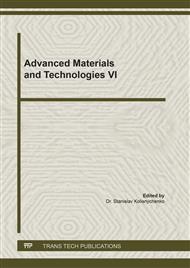[1]
X. Li, J. Zhai, H. Li, X. Gao, An integration recycling process for cascade utilization of waste engine oil by distillation and microwave-assisted pyrolysis, Fuel Process. Technol. 199 (2020) 106245. doi:https://doi.org/10.1016/j.fuproc.2019.106245.
DOI: 10.1016/j.fuproc.2019.106245
Google Scholar
[2]
M.T. Rahman, A. Mohajerani, F. Giustozzi, Recycling of Waste Materials for Asphalt Concrete and Bitumen: A Review, Mater. (Basel, Switzerland). 13 (2020) 1495.
DOI: 10.3390/ma13071495
Google Scholar
[3]
A. Eleyedath, A.K. Swamy, 3 - Use of waste engine oil in materials containing asphaltic components, in: F. Pacheco-Torgal, S. Amirkhanian, H. Wang, E.B.T.-E.-E.P.C.M. Schlangen (Eds.), Woodhead Publ. Ser. Civ. Struct. Eng., Woodhead Publishing, 2020: p.33–50. doi:https://doi.org/10.1016/B978-0-12-818981-8.00003-5.
DOI: 10.1016/b978-0-12-818981-8.00003-5
Google Scholar
[4]
A. Woszuk, M. Wróbel, W. Franus, Influence of Waste Engine Oil Addition on the Properties of Zeolite-Foamed Asphalt, Mater. (Basel, Switzerland). 12 (2019).
DOI: 10.3390/ma12142265
Google Scholar
[5]
S. Hou, C. Chen, J. Zhang, H. Shen, F. Gu, Thermal and mechanical evaluations of asphalt emulsions and mixtures for microsurfacing, Constr. Build. Mater. 191 (2018) 1221–1229.
DOI: 10.1016/j.conbuildmat.2018.10.091
Google Scholar
[6]
O.N. Burenina, M.E. Savvinova, A. V Andreeva, The Effectiveness of Using Bitumen Emulsion in the Technology of Dedusting Roads with a Transitional Type of Coating, Mater. Sci. Forum. 992 (2020) 9–14.
DOI: 10.4028/www.scientific.net/msf.992.9
Google Scholar
[7]
A. Khan, P. Redelius, N. Kringos, Effects of surfactants and adhesion promoters on the bitumen-minerals interfacial bond during breaking of bitumen emulsions, (n.d.). http://kth.diva-portal.org/smash/get/diva2:1184457/FULLTEXT01.pdf.
Google Scholar
[8]
L. Boucard, V. Schmitt, E. Chailleux, F. Farcas, V. Gaudefroy, Bitumen-in-water emulsion: Destabilization by electrolyte solutions and rheological evaluation, in: 6th Eurasphalt Eurobitume Congr., 2016.
DOI: 10.14311/ee.2016.168
Google Scholar
[9]
F. Goodarzi, S. Zendehboudi, A Comprehensive Review on Emulsions and Emulsion Stability in Chemical and Energy Industries, Can. J. Chem. Eng. 97 (2019) 281–309. doi:https://doi.org/10.1002/cjce.23336.
DOI: 10.1002/cjce.23336
Google Scholar
[10]
V. Carrera, A.A. Cuadri, M. García-Morales, P. Partal, The development of polyurethane modified bitumen emulsions for cold mix applications, Mater. Struct. Constr. 48 (2015) 3407–3414.
DOI: 10.1617/s11527-014-0408-2
Google Scholar
[11]
M. Iwański, A. Chomicz-Kowalska, Laboratory Study on Mechanical Parameters of Foamed Bitumen Mixtures in the Cold Recycling Technology, Procedia Eng. 57 (2013) 433–442.
DOI: 10.1016/j.proeng.2013.04.056
Google Scholar
[12]
A.A. Haleem Khan, S. Mohan Karuppayil, Fungal pollution of indoor environments and its management, Saudi J. Biol. Sci. 19 (2012) 405–426.
DOI: 10.1016/j.sjbs.2012.06.002
Google Scholar
[13]
M.A. Egbuta, M. Mwanza, O.O. Babalola, Health Risks Associated with Exposure to Filamentous Fungi., Int. J. Environ. Res. Public Health. 14 (2017).
DOI: 10.3390/ijerph14070719
Google Scholar
[14]
S.N. Baxi, J.M. Portnoy, D. Larenas-Linnemann, W. Phipatanakul, C. Barnes, C. Grimes, W.E. Horner, K. Kennedy, E. Levetin, J.D. Miller, J. Scott, B. Williams, Exposure and Health Effects of Fungi on Humans, J. Allergy Clin. Immunol. Pract. 4 (2016) 396–404.
DOI: 10.1016/j.jaip.2016.01.008
Google Scholar
[15]
A. Graziani, E. Pasquini, G. Ferrotti, A. Virgili, F. Canestrari, Structural response of grid-reinforced bituminous pavements, Mater. Struct. 47 (2014) 1391–1408.
DOI: 10.1617/s11527-014-0255-1
Google Scholar
[16]
C. Oliviero Rossi, A. Spadafora, B. Teltayev, G. Izmailova, Y. Amerbayev, V. Bortolotti, Polymer modified bitumen: Rheological properties and structural characterization, Colloids Surfaces A Physicochem. Eng. Asp. 480 (2015) 390–397.
DOI: 10.1016/j.colsurfa.2015.02.048
Google Scholar
[17]
Y. Cheng, W. Wang, G. Tan, C. Shi, Assessing high- and low-temperature properties of asphalt pavements incorporating waste oil shale as an alternative material in Jilin Province, China, Sustainability. 10 (2018).
DOI: 10.3390/su10072179
Google Scholar
[18]
M. Ali, Mixture characteristics of buton rock asphalt, Universiti Tun Hussein Onn Malaysia, (2011).
DOI: 10.30880/ijie.2022.14.05.005
Google Scholar
[19]
S. Ammann, A. Ammann, R. Ravotti, L.J. Fischer, A. Stamatiou, J. Worlitschek, Effective Separation of a Water in Oil Emulsion from a Direct Contact Latent Heat Storage System, Energies. 11 (2018) 1–15.
DOI: 10.3390/en11092264
Google Scholar
[20]
National Research Council, Coatings for High-Temperature Structural Materials: Trends and Opportunities, The National Academies Press, Washington, DC, 1996.
Google Scholar
[21]
S. Yero, M. Hainin, Viscosity Characteristics of Modified Bitumen, ARPN J. Sci. Technol. 2 (2011) 500–503. http://www.ejournalofscience.org/archive/vol2no5/vol2no5_15.pdf.
Google Scholar
[22]
D. V. Rosato, D. V. Rosato, Plastics Engineered Product Design, Elsevier Ltd, 2003.
Google Scholar
[23]
E. Remišová, M. Holý, Changes of Properties of Bitumen Binders by Additives Application, in: IOP Conf. Ser. Mater. Sci. Eng., Institute of Physics Publishing, 2017.
DOI: 10.1088/1757-899x/245/3/032003
Google Scholar
[24]
H. Murata, Rheology - Theory and Application to Biomaterials, in: Polymerization, InTech, 2012.
Google Scholar
[25]
A.M.O. Zapata, S. Rodríguez-Barona, G.I.G. Gómez, Rheological characterization and stability study of an emulsion made with a dairy by-product enriched with omega-3 fatty acids, Brazilian J. Food Technol. 18 (2015) 23–30.
DOI: 10.1590/1981-6723.2014
Google Scholar
[26]
C.W. Macosko, Rheology : principles, measurements, and applications, VCH, (1994).
Google Scholar
[27]
H. Zhai, D. Salomon, E. Milliron, Using Rheological Properties to Evaluate Storage Stability and Setting Behaviors of Emulsified asphalts, Idaho Asph. Supply, Inc. White Pap. Idaho. (2006) 1–10.
Google Scholar
[28]
T. Shoukat, P.J. Yoo, Rheology of Asphalt Binder Modified with 5W30 Viscosity Grade Waste Engine Oil, Appl. Sci. . 8 (2018).
DOI: 10.3390/app8071194
Google Scholar
[29]
C. Oliviero Rossi, B. Teltayev, R. Angelico, Adhesion Promoters in Bituminous Road Materials: A Review, Appl. Sci. 7 (2017) 524.
DOI: 10.3390/app7050524
Google Scholar
[30]
G. Xu, H. Wang, Study of cohesion and adhesion properties of asphalt concrete with molecular dynamics simulation, Comput. Mater. Sci. 112 (2016) 161–169.
DOI: 10.1016/j.commatsci.2015.10.024
Google Scholar


